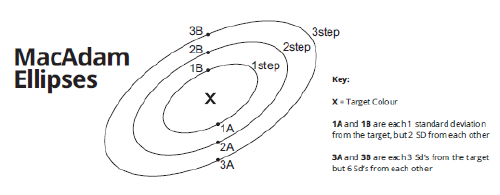Standard Deviation Colour Matching (SDCM) is a statistical technique used to define how closely (or not) two colours match each other. If two colours are within 1 standard deviation of each other they will appear to most people to be the same. As the standard deviations between samples increase the difference between them becomes apparent to more people.
The use of Standard Deviation Colour Matching was first used in a large-scale experiment by David MacAdam in 1942. Using the SDCM technique MacAdam defined a line round 25 target colours on the CIE 1931 colour space diagram. The line described all points positioned 1 standard deviation from the target colour and in all 25 instances was elliptical in shape. Within each ellipse all colours appeared to MacAdam and his co-workers to match the target, while around the ellipse there was a noticeable difference between any colour and the target inside the ellipse.
MacAdam ellipses are used today (2021) to quantify the colour match between light sources.
Why is Standard Deviation Colour Matching important? No two light sources will ever emit exactly the same colour of light, but because multiple lights are generally installed next to each other a degree of consistency is very desirable. Therefore, lighting engineers need a way to express a tolerance around a target colour, in the same way that a mechanical engineer will express a tolerance round a dimension. For the lighting engineer the tolerance of a colour is expressed as a 1-step, 2-step, 3-step (etc) MacAdam ellipse.

MacAdam’s ellipses plotted on the CIE 1931 colour space diagram, shown at 10x actual size.
MacAdam’s own work defined the colour space encircled by a line drawn at 1 standard deviation from each of the 25 target colours. Assuming a normal distribution of readings round the target additional concentric lines can be drawn representing 2, 3 and more standard deviations from the target, as below:

For more information on David MacAdam’s work and how a standard deviation of a colour was identified,
please read the article " What did David MacAdam do? "